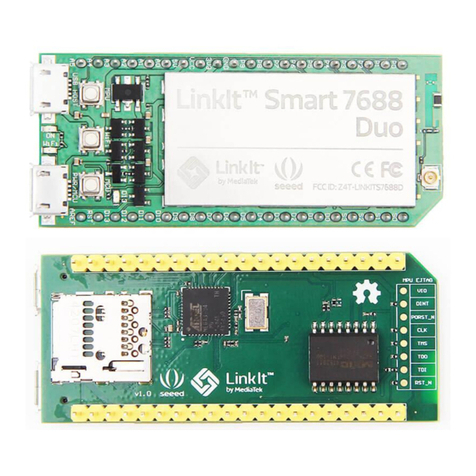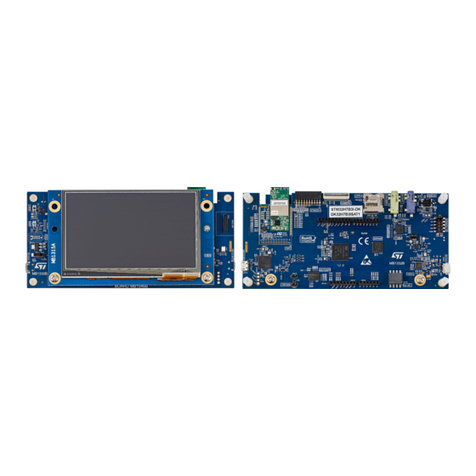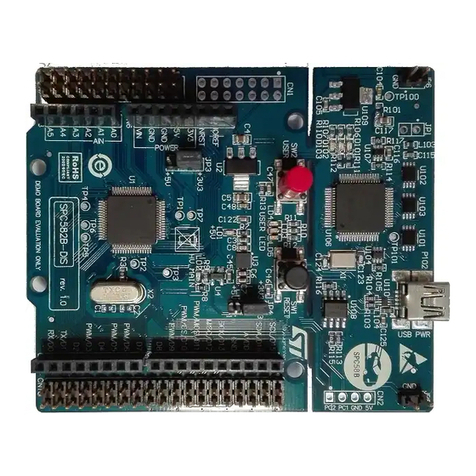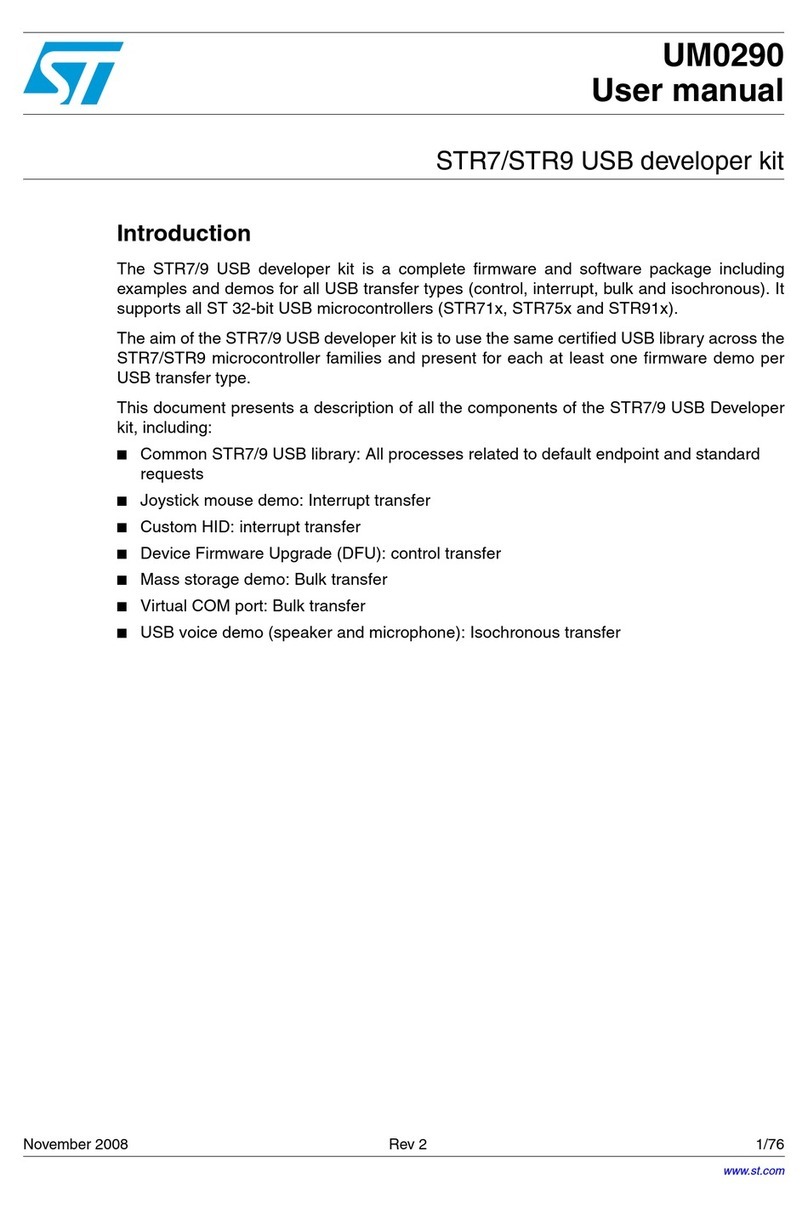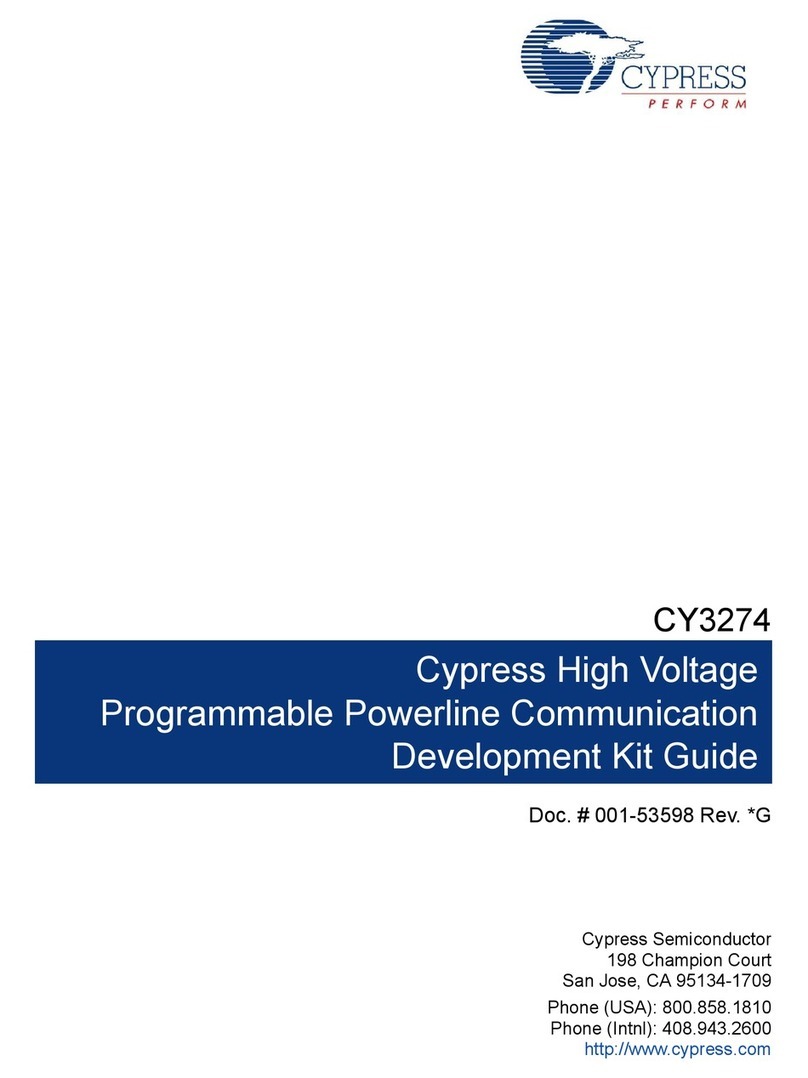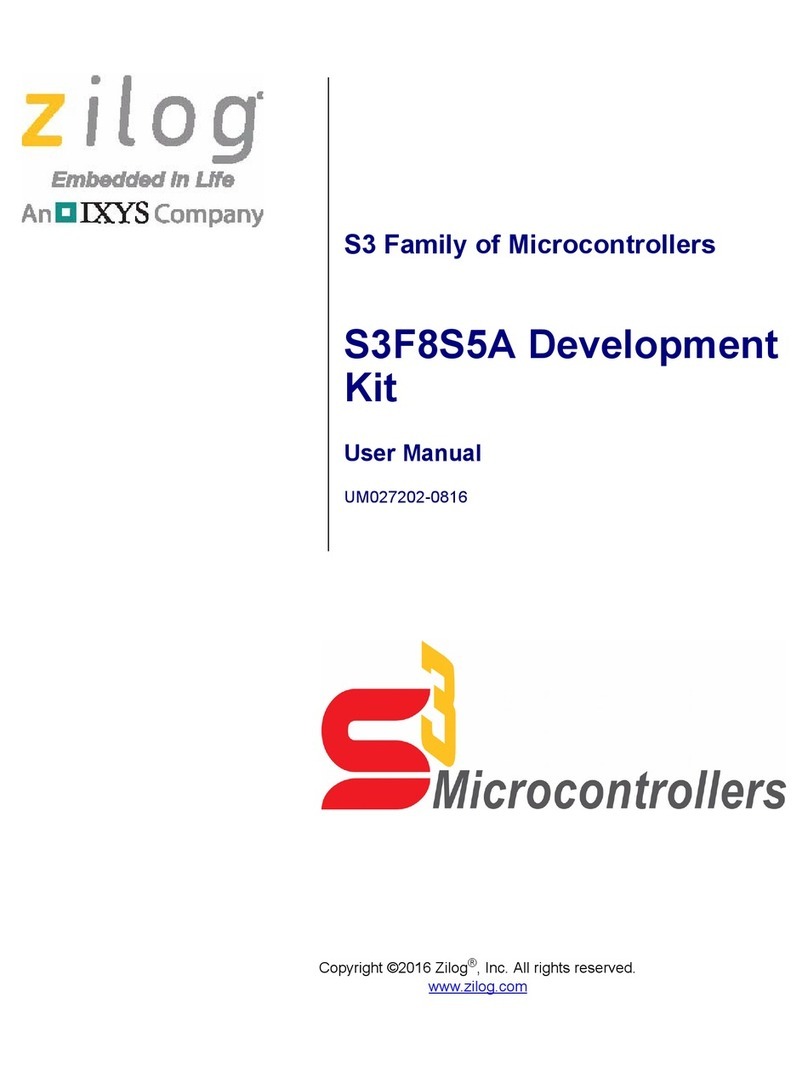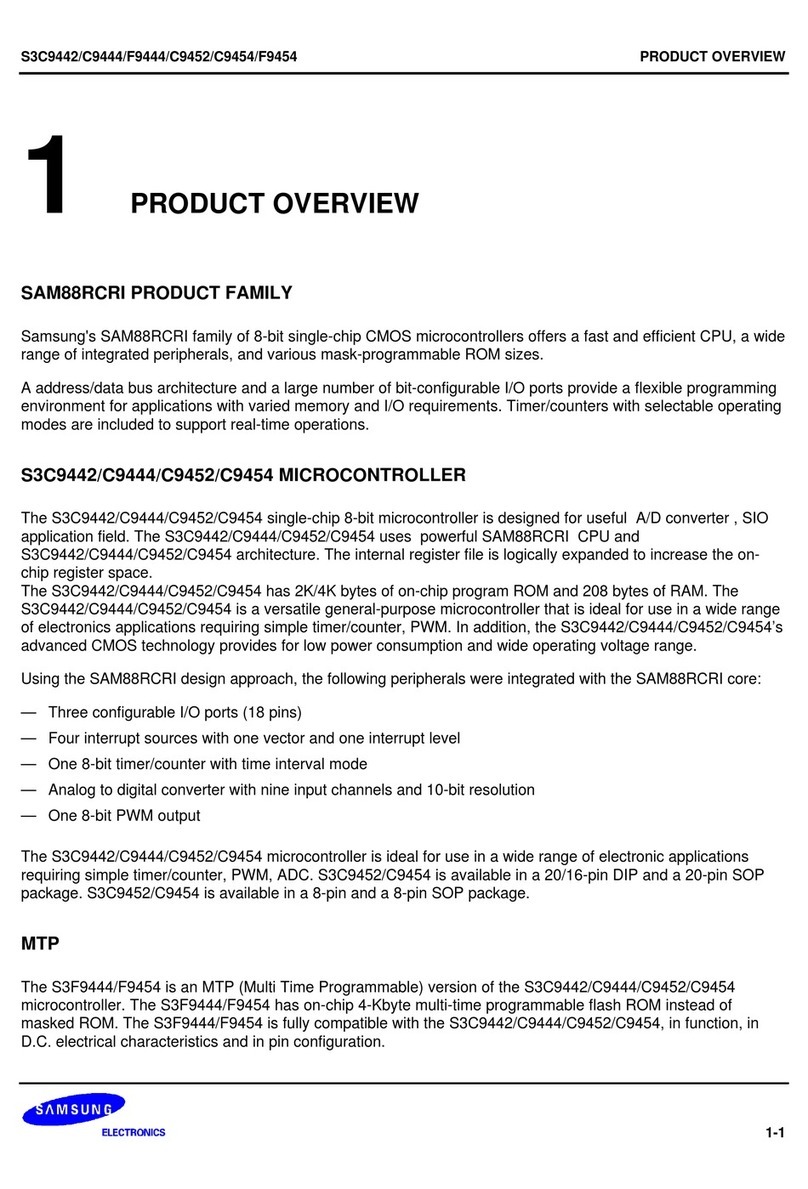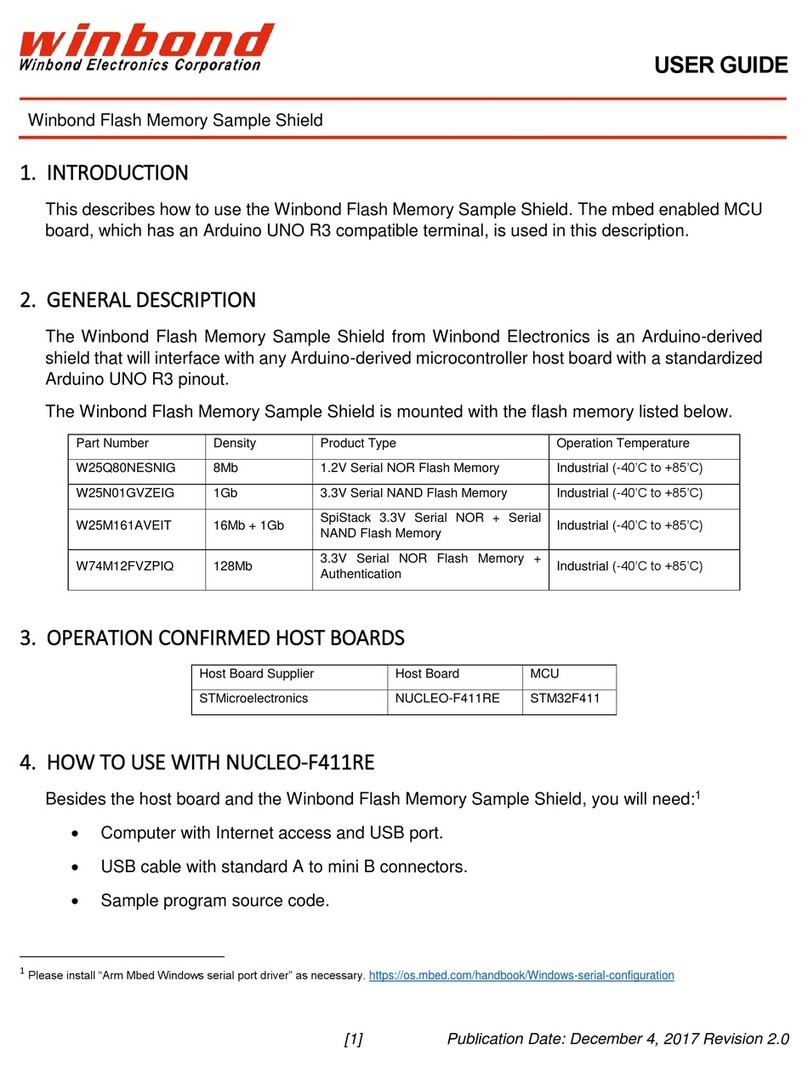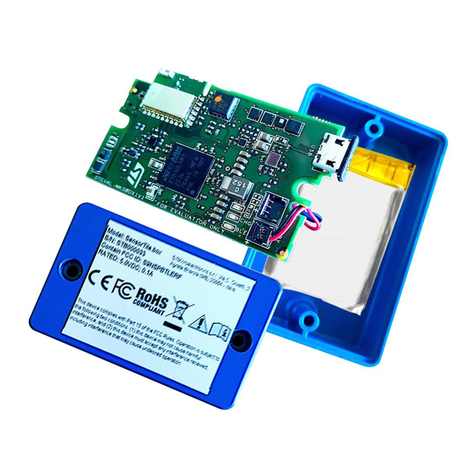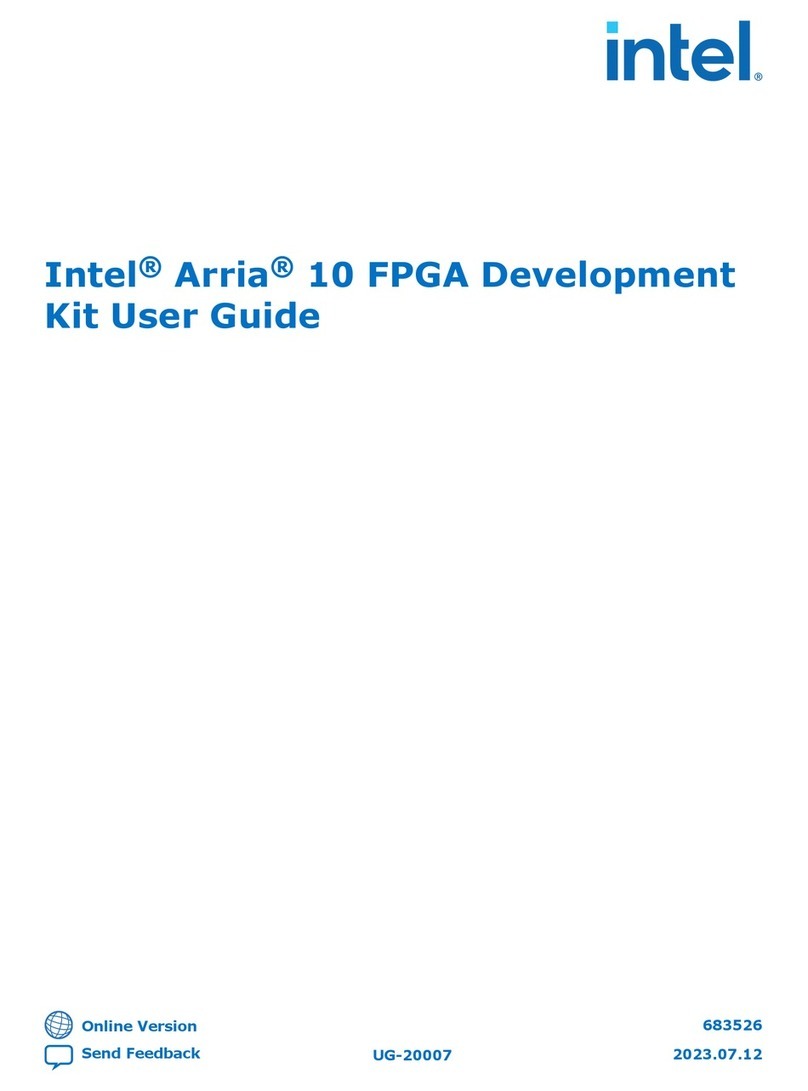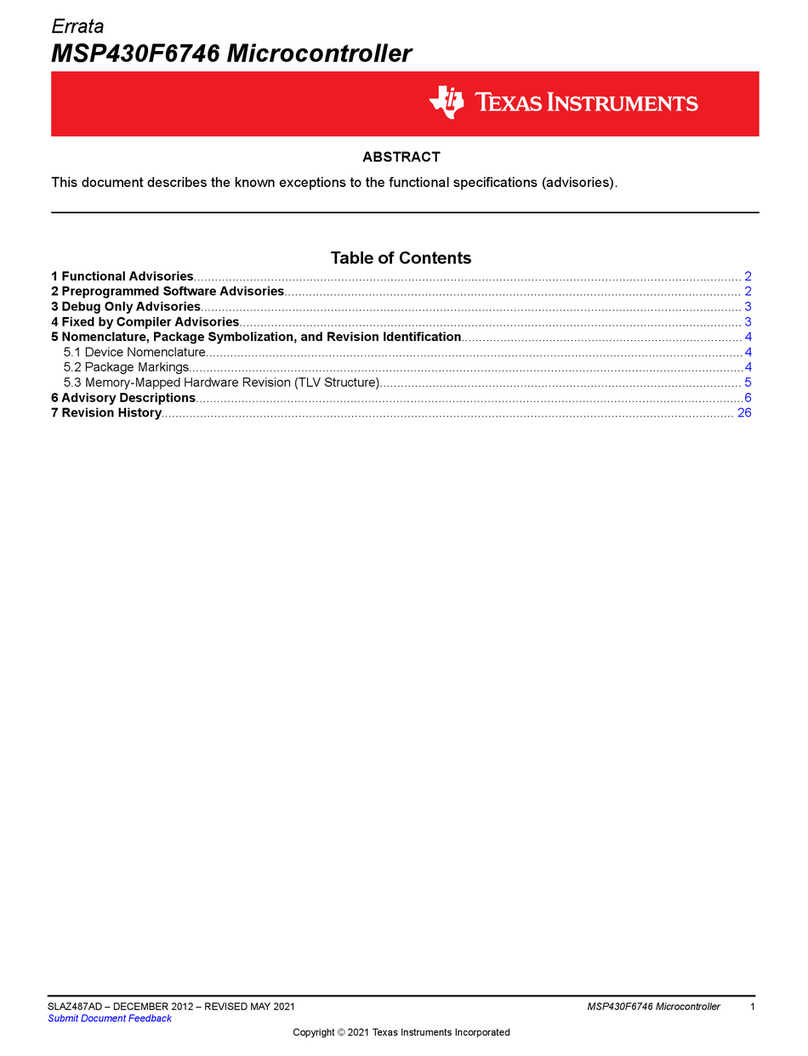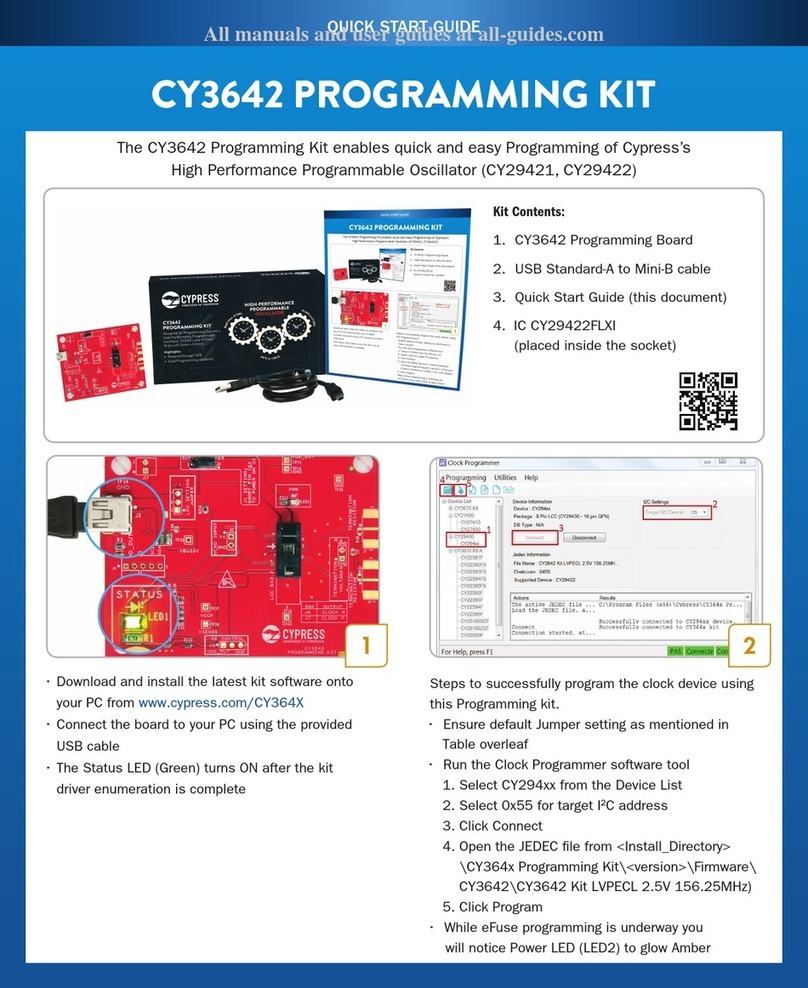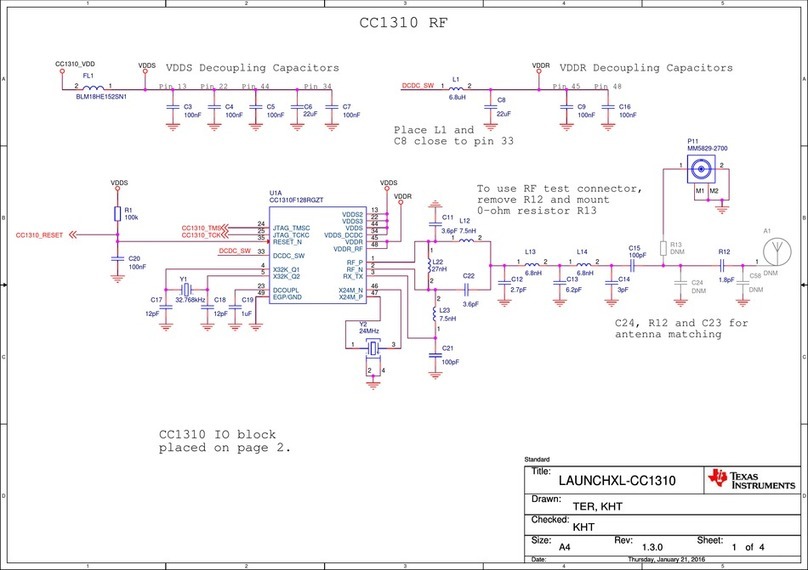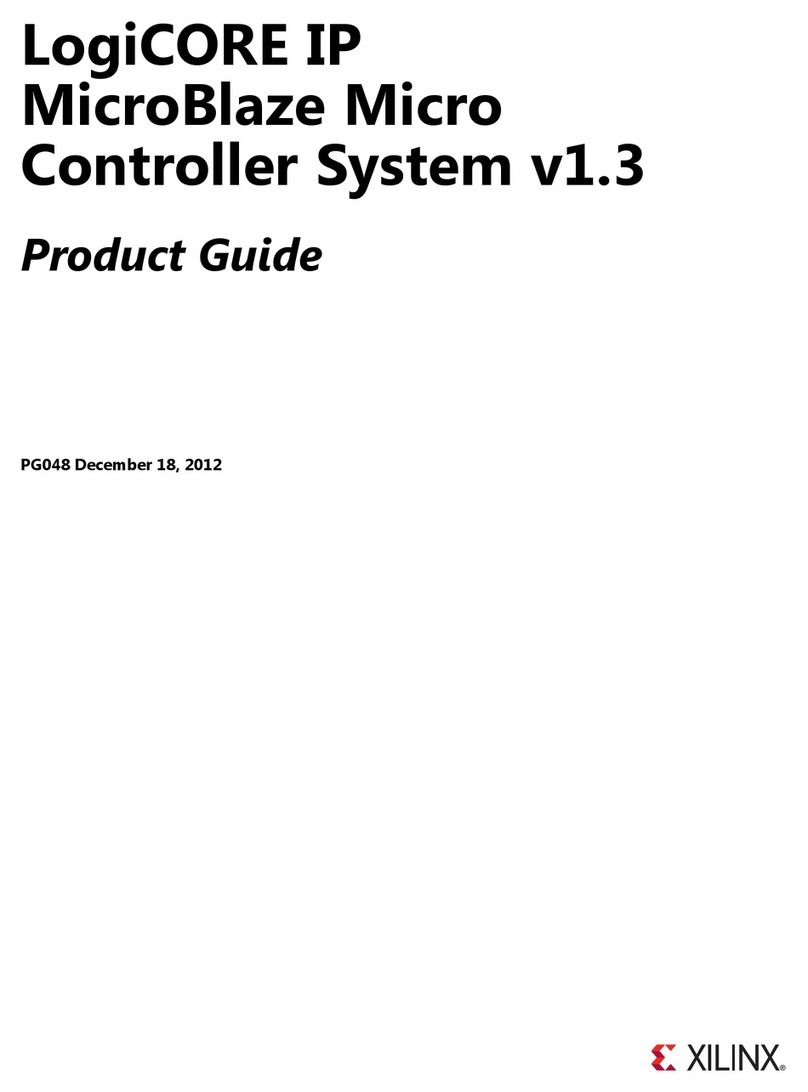MEDIATEK LinkIt 2523 HDK v11 User manual

LinkIt 2523 HDK v11 User's Guide
Version: 1.1
Release date: 4 November 2016
© 2015 - 2016 MediaTek Inc.
This document contains information that is proprietary to MediaTek Inc. (“MediaTek”) and/or its licensor(s). MediaTek cannot grant you
permission for any material that is owned by third parties. You may only use or reproduce this document if you have agreed to and been
bound by the applicable license agreement with MediaTek (“License Agreement”) and been granted explicit permission within the License
Agreement (“Permitted User”). If you are not a Permitted User, please cease any access or use of this document immediately. Any
unauthorized use, reproduction or disclosure of this document in whole or in part is strictly prohibited. THIS DOCUMENT IS PROVIDED ON AN
“AS-IS” BASIS ONLY. MEDIATEK EXPRESSLY DISCLAIMS ANY AND ALL WARRANTIES OF ANY KIND AND SHALL IN NO EVENT BE LIABLE FOR ANY
CLAIMS RELATING TO OR ARISING OUT OF THIS DOCUMENT OR ANY USE OR INABILITY TO USE THEREOF. Specifications contained herein are
subject to change without notice.

LinkIt 2523 HDK v11 User's Guide
© 2015 - 2016 MediaTek Inc. Page i of v
This document contains information that is proprietary to MediaTek Inc. (“MediaTek”) and/or its licensor(s).
Any unauthorized use, reproduction or disclosure of this document in whole or in part is strictly prohibited.
Document Revision History
Revision Date Description
1.0 2 September 2016 Initial release. This document is for LinkIt 2523 HDK v11.
1.1 4 November 2016 •Updated introduction to include top and bottom views of the
LinkIt 2523 HDK v11.
•Updated the section for Bluetooth and Bluetooth Low Energy.
•Updated the schematic and the BOM list.

LinkIt 2523 HDK v11 User's Guide
© 2015 - 2016 MediaTek Inc. Page ii of v
This document contains information that is proprietary to MediaTek Inc. (“MediaTek”) and/or its licensor(s).
Any unauthorized use, reproduction or disclosure of this document in whole or in part is strictly prohibited.
Table of contents
1. Introduction........................................................................................................................................ 1
2. Get Started with the HDK .................................................................................................................... 3
2.1. Installing the LinkIt 2523 HDK drivers on Microsoft Windows ...........................................................3
2.2. Downloading the project image using the LinkIt 2523 HDK as a removable storage.........................6
3. Hardware Description ......................................................................................................................... 7
4. Hardware Configuration.................................................................................................................... 10
4.1. Microcontroller unit .........................................................................................................................10
4.2. Power................................................................................................................................................10
4.3. Jumpers ............................................................................................................................................16
4.4. LEDs .................................................................................................................................................. 18
4.5. Buttons .............................................................................................................................................20
4.6. GPIO.................................................................................................................................................. 21
4.7. LCM...................................................................................................................................................22
4.8. Audio ................................................................................................................................................25
4.9. Speech ..............................................................................................................................................25
4.10. MSDC ................................................................................................................................................ 25
4.11. Camera .............................................................................................................................................27
4.12. USB ...................................................................................................................................................29
4.13. GNSS (LinkIt 2523G only).................................................................................................................. 30
4.14. Bluetooth and Bluetooth Low Energy...............................................................................................30
4.15. Debugging.........................................................................................................................................32
4.16. Connectors........................................................................................................................................34
5. Schematics (V11)............................................................................................................................... 49
6. Layout (V11)...................................................................................................................................... 71
7. LinkIt 2523 HDK’s BOM (V11) ............................................................................................................ 75
8. Appendix A: Acronyms and Abbreviations ......................................................................................... 82

LinkIt 2523 HDK v11 User's Guide
© 2015 - 2016 MediaTek Inc. Page iii of v
This document contains information that is proprietary to MediaTek Inc. (“MediaTek”) and/or its licensor(s).
Any unauthorized use, reproduction or disclosure of this document in whole or in part is strictly prohibited.
Lists of tables and figures
Table 1. Power input jumpers...............................................................................................................................10
Table 2. GPIO voltage level customization with jumper and pin (illustrated) settings .........................................11
Table 3. Enabling the active GPS antenna on HDK with jumper pin settings (illustrated)....................................13
Table 4. PSRAM power source selection jumpers.................................................................................................14
Table 5. Serial flash I/O power source selection jumper ......................................................................................15
Table 6. Analog I/O power source selection jumper.............................................................................................15
Table 7. LinkIt 2523 HDK jumper index.................................................................................................................16
Table 8. The LED indicators...................................................................................................................................18
Table 9. Buttons and corresponding keypad functionality ...................................................................................20
Table 10. LinkIt 2523 board’s eFuse jumper pin settings (illustrated)..................................................................22
Table 11. LinkIt 2523 board’s RTC jumper pin settings.........................................................................................22
Table 12. LCM backlight source selection settings (illustrated)............................................................................23
Table 13. LinkIt 2523 HDK display peripheral jumper pin settings (illustrated)....................................................24
Table 14. Jumper settings (illustrated) for storage options ..................................................................................25
Table 15. Jumper pin settings (illustrated) for camera and sensor daughterboards............................................28
Table 16. Jumper pin settings (illustrated) for Bluetooth .....................................................................................31
Table 17. Resistor selections.................................................................................................................................33
Table 18. Battery connector CON2101 (see Figure 18).........................................................................................34
Table 19. Micro-SD tray ........................................................................................................................................35
Table 20. OMTP Audio jack connector..................................................................................................................35
Table 21. LCM serial display daughterboard connector .......................................................................................36
Table 22. Serial camera daughterboard connector CON6201 ..............................................................................37
Table 23. Sensor daughterboard connector CON6301 .........................................................................................38
Table 24.The HDK’s high speed USB 2.0 connector ..............................................................................................39
Table 25. CMSIS-DAP USB full speed connector ...................................................................................................40
Table 26. MK20 JTAG connector pin definition.....................................................................................................41
Table 27. eMMC/micro SD jumpers......................................................................................................................41
Table 28. JTAG connector CON9002 .....................................................................................................................41
Table 29. GPIO pin functionalities.........................................................................................................................43
Table 30. LinkIt 2523 HDK bill of materials ...........................................................................................................75
Table 31. Acronyms and abbreviations.................................................................................................................82
Figure 1. Top view of the LinkIt 2523 HDK v11 .......................................................................................................1
Figure 2. Bottom view of the LinkIt 2523 HDK v11 .................................................................................................2
Figure 3. USB connectors on the LinkIt 2523 development board .........................................................................3
Figure 4. Device COM port for debugging on your PC ............................................................................................4
Figure 5. Device COM port for logging on your PC .................................................................................................5
Figure 6. A typical USB to UART converter..............................................................................................................5
Figure 7. LinkIt 2523 HDK connected as removable disk storage ...........................................................................6
Figure 8. LinkIt 2523 HDK’s top view.......................................................................................................................8
Figure 9. LinkIt 2523 HDK’s bottom view................................................................................................................9

LinkIt 2523 HDK v11 User's Guide
© 2015 - 2016 MediaTek Inc. Page iv of v
This document contains information that is proprietary to MediaTek Inc. (“MediaTek”) and/or its licensor(s).
Any unauthorized use, reproduction or disclosure of this document in whole or in part is strictly prohibited.
Figure 10. The positions of jumpers J1105, J1110 to J1112. J1114, resistors R4101, R1113, GPDAC test point TP1101
and micro SD cardholder ......................................................................................................................................12
Figure 11. The jumper positions for J5201 and J5202, J1106, J1108, J1109.........................................................14
Figure 12. LED positions for LED2001, LED2003 and LED6601 .............................................................................19
Figure 13. LED positions for LED9201, LED9206 and LED9209 .............................................................................20
Figure 14. The positions of buttons, strap pin resistors, jumpers J1102 to J1104................................................21
Figure 15. LCM display module and backlight jumper locations ..........................................................................23
Figure 16. Jumpers J1001 to J1006 for storage options........................................................................................27
Figure 17. Jumper pin locations of J1007 to J1012, J1015....................................................................................28
Figure 18. Positions of J1101 and Bluetooth antenna path selection from J5001 to J5004, U1101, CON2101 and
resistor R5005 .......................................................................................................................................................31
Figure 19. The positions of UART and I2C pin header for debugging facilitation .................................................34
Figure 20. Micro-SD card holder CON4101...........................................................................................................35
Figure 21. Serial LCM daughterboard’s connector and I2C pull-up resistors (R1002, R1003) .............................36
Figure 22. Serial camera daughterboard CON6201 ..............................................................................................37
Figure 23. The position of the camera daughterboard pin headers .....................................................................37
Figure 24. High-speed USB2.0 connector .............................................................................................................39
Figure 25. CMSIS-DAP USB 1.1 full speed connector ............................................................................................39
Figure 26. MK20 JTAG connector, sensor daughterboard connector and PSRAM power switch J1113 ..............40
Figure 27. JTAG connector CON9002 pin definition .............................................................................................42
Figure 28. LinkIt 2523 HDK extension connectors ................................................................................................43
Figure 29. Block diagram.......................................................................................................................................50
Figure 30. I2C ID ....................................................................................................................................................51
Figure 31. PMU_SPEC............................................................................................................................................52
Figure 32. BB MT2523G BB ...................................................................................................................................53
Figure 33. BB_MT2523G_ABB...............................................................................................................................54
Figure 34. POWER_COMMON_LDO......................................................................................................................55
Figure 35. POWER_Charging .................................................................................................................................56
Figure 36. MEMORY_eMMC .................................................................................................................................57
Figure 37. MEMORY_SD Card ...............................................................................................................................58
Figure 38. CONNECTIVITY_BT_MT2523G..............................................................................................................59
Figure 39. CONNECTIVITY_GPS_MT2523G ...........................................................................................................60
Figure 40. PERI_Audio_IO .....................................................................................................................................61
Figure 41. PERI_LCD_Capacitive touch panel........................................................................................................62
Figure 42. PERI_CAMERA ......................................................................................................................................63
Figure 43. PERI_SENSOR_DTB_IO .........................................................................................................................64
Figure 44. PERI_USB..............................................................................................................................................65
Figure 45. PERI_KEY ..............................................................................................................................................66
Figure 46. PERI_SWD.............................................................................................................................................67
Figure 47. DEBUG_IO ............................................................................................................................................68
Figure 48. POWER INDICATOR ..............................................................................................................................69
Figure 49. LCM ......................................................................................................................................................70
Figure 50. LinkIt 2523 HDK layout (Layer 1)..........................................................................................................71
Figure 51. LinkIt 2523 HDK layout (Layer 2)..........................................................................................................72

LinkIt 2523 HDK v11 User's Guide
© 2015 - 2016 MediaTek Inc. Page v of v
This document contains information that is proprietary to MediaTek Inc. (“MediaTek”) and/or its licensor(s).
Any unauthorized use, reproduction or disclosure of this document in whole or in part is strictly prohibited.
Figure 52. LinkIt 2523 HDK layout (Layer 3)..........................................................................................................73
Figure 53. LinkIt 2523 HDK layout (Layer 4)..........................................................................................................74

LinkIt 2523 HDK v11 User's Guide
© 2015 - 2016 MediaTek Inc. Page 1 of 82
This document contains information that is proprietary to MediaTek Inc. (“MediaTek”) and/or its licensor(s).
Any unauthorized use, reproduction or disclosure of this document in whole or in part is strictly prohibited.
1. Introduction
MediaTek LinkIt™ 2523 hardware development kit (HDK) by SAC is a fully functional development platform for
RTOS for IoT and Wearable applications powered by MediaTek MT2523G, an ARM Cortex-M4 core-based
microcontroller unit (MCU). The HDK has rich connectivity features and interfaces such as SPI, I2S, PCM, UART,
ADC, PWM, JTAG and clock out generators.
The LinkIt 2523 HDK enables application development, prototyping and evaluation using sensors, Bluetooth,
Bluetooth low energy, GNSS, audio (speech, headset and speaker), MIPI, serial, camera serial interface, keypad,
battery management, micro SD and eMMC portable storage support and high speed USB 2.0. The LinkIt 2523 HDK
also has built-in antenna that is able to receive Bluetooth (compatibility with up to 4.0 and higher versions), and
GNSS (GPS, GLONASS and BeiDou) signals. In addition, the USB to serial wire debug (SWD) converter and JTAG
feature provides convenient development and debugging.
The LinkIt 2523 HDK supports OpenSDA to provide more streamlined development to debug and flash the binary
code.
This user’s guide covers MT2523G and MT2523D integrated chipsets. The functions and pin assignments from both
chipsets are identical, except the MT2523D doesn’t support GNSS communication.
The user manual guides you through the following.
•Describing the hardware features of the LinkIt 2523 HDK.
•Configuring the LinkIt 2523 HDK with specific pin and jumper assignments.
•Providing the hardware schematics for more detailed configuration and reference design.
•Listing bill of materials (BOM) for the LinkIt 2523 HDK.
Front and back views of the LinkIt 2523 HDK version 11 are presented in Figure 1 and Figure 2, respectively.
Figure 1. Top view of the LinkIt 2523 HDK v11

LinkIt 2523 HDK v11 User's Guide
© 2015 - 2016 MediaTek Inc. Page 2 of 82
This document contains information that is proprietary to MediaTek Inc. (“MediaTek”) and/or its licensor(s).
Any unauthorized use, reproduction or disclosure of this document in whole or in part is strictly prohibited.
Figure 2. Bottom view of the LinkIt 2523 HDK v11

LinkIt 2523 HDK v11 User's Guide
© 2015 - 2016 MediaTek Inc. Page 3 of 82
This document contains information that is proprietary to MediaTek Inc. (“MediaTek”) and/or its licensor(s).
Any unauthorized use, reproduction or disclosure of this document in whole or in part is strictly prohibited.
2. Get Started with the HDK
This section provides details on how to configure the HDK and install the required peripheral drivers for the full
operation of the development platform.
Before commencing the application development, set the jumpers for the camera daughterboard, as shown in
Figure 3.
Figure 3. USB connectors on the LinkIt 2523 development board
The 2523 USB can be used for powering up the board and downloading the binary with LinkIt 2523 Flash Tool.
The MK20 USB can be used for debugging with GDB and downloading the binary using Keil IDE. To learn more
about 2523 USB COM port driver, see section 2.3, “Installing the USB driver” of MT2523 Flash Tool Users Guide.
2.1. Installing the LinkIt 2523 HDK drivers on Microsoft Windows
Install mbed serial port driver to use the USB serial port on Windows OS for debugging:
1) Download and install the Windows serial port driver from here.
2) Connect the board to the computer through 2523 USB and the MK20 USB.
3) Open Windows Control Panel, click System and:
•On Windows 7 and 8, click Device Manager.
•On Windows XP, click the Hardware tab and then Device Manager.
4) In Device Manager, navigate to Ports (COM & LPT) (see Figure 4).
Jumpers for the Camera
Daughterboard
2523 USB
MK20 USB
System
Power
3 2 1

LinkIt 2523 HDK v11 User's Guide
© 2015 - 2016 MediaTek Inc. Page 4 of 82
This document contains information that is proprietary to MediaTek Inc. (“MediaTek”) and/or its licensor(s).
Any unauthorized use, reproduction or disclosure of this document in whole or in part is strictly prohibited.
A new COM device should appear under Ports (COM & LPT), as shown in Figure 4. Note the COMx port
number of the mbed Serial Port. Use this port to send and receive data to and from the LinkIt 2523 HDK.
Figure 4. Device COM port for debugging on your PC
To install a USB to UART driver, such as prolific USB to UART converter:
1) Connect a USB to UART cable to PC, such as USB to Serial/UART Bridge Controller (Integrated crystal/OTP).
A new unknown device will be detected on Microsoft Windows system, if the device driver wasn’t setup
before.
2) Download and install the USB to UART cable driver from Prolific. After the driver is installed, unknown
device will be changed to Prolific USB-to-Serial Comm Port.
3) Open Windows Control Panel, click System.
•On Windows 7 and 8, click Device Manager.
•On Windows XP, click the Hardware tab and then Device Manager.
4) In Device Manager, navigate to Ports (COM & LPT) (see Figure 5). A new COM device should appear.
Note the COMx port number of the Prolific USB-to-Serial Comm Port. The COM port can now be used
to receive system logs through the UART interface on the LinkIt 2523 HDK.

LinkIt 2523 HDK v11 User's Guide
© 2015 - 2016 MediaTek Inc. Page 5 of 82
This document contains information that is proprietary to MediaTek Inc. (“MediaTek”) and/or its licensor(s).
Any unauthorized use, reproduction or disclosure of this document in whole or in part is strictly prohibited.
Figure 5. Device COM port for logging on your PC
A typical USB to UART converter is shown in Figure 6. The USB connector should be connected to the PC. The jump
wires (count of four) should be connected to the UART interface on the LinkIt 2523 HDK. Connect the black wire to
the GND, the white wire to the RX and the green wire to the TX and no need to connect the red wire. Once the
converter is connected, the system logs will display on the serial monitor tool, such as Tera Terminal. Figure 19
shows the UART port connector location.
Figure 6. A typical USB to UART converter

LinkIt 2523 HDK v11 User's Guide
© 2015 - 2016 MediaTek Inc. Page 6 of 82
This document contains information that is proprietary to MediaTek Inc. (“MediaTek”) and/or its licensor(s).
Any unauthorized use, reproduction or disclosure of this document in whole or in part is strictly prohibited.
2.2. Downloading the project image using the LinkIt 2523 HDK as a
removable storage
To update the FreeRTOS image only (example project image: iot_sdk_demo.bin) use the LinkIt 2523 HDK as a
removable disk drive according to the following steps:
1) Connect the LinkIt 2523 HDK to your PC with a micro-USB cable to the MK20 USB connector.
2) Navigate to Computer on your PC to check if a new mass storage named MT2523 is available
under Devices with Removable Storage, as shown in Figure 7.
Figure 7. LinkIt 2523 HDK connected as removable disk storage
3) Open the MT2523 removable storage, then drag and drop the project image, such as
iot_sdk_demo.bin, from the original image folder to update the image on the HDK’s flash.

LinkIt 2523 HDK v11 User's Guide
© 2015 - 2016 MediaTek Inc. Page 7 of 82
This document contains information that is proprietary to MediaTek Inc. (“MediaTek”) and/or its licensor(s).
Any unauthorized use, reproduction or disclosure of this document in whole or in part is strictly prohibited.
3. Hardware Description
LinkIt 2523 HDK provides connections between the system on chip (SOC) and the peripherals, such as micro SD
card, eMMC, MIPI LCM, serial LCM, touch panel, serial camera, sensor daughterboard, GNSS, Bluetooth, audio
speech and high speed USB 2.0.
The top and bottom layout views (Figure 8 and Figure 9, respectively) show the positions of the peripherals on the
development board. Some of the peripheral interfaces are mutually exclusive. The eMMC and the micro SD, for
example, cannot be used at the same time, as the corresponding pins can only be assigned to one function at a
time.
The LinkIt 2523 HDK provides the following features for application development.
•ARM Cortex-M4 core-based MT2523G microcontroller.
•Internal 160kB SRAM and 4MB PSRAM.
•Internal 4MB serial flash.
•Rich interfaces.
•Three I2Cs.
•Four master SPIs and a slave SPI.
•One master I2S and one slave I2S.
•One PCM interface that supports master.
•Four sets of UARTs. The first set of UART is directly configured through pin headers, the other three sets
are software configurable.
•Five 12-bit ADCs.
•Six PWMs by alternative voltage level.
•Two SDMMCs.
•JTAG debugging support.
•Five sets of clock outputs.
•Peripherals.
•One serial camera interface supporting up to 3-bit mode image capture.
•Two display modes supporting serial interface and MIPI with the resolution of up to 320*320 pixels.
•Keypad supported to simulate buttons, such as volume up or down, backward and enter.
•Onboard speaker, onboard analog microphone and audio jack appliance.
•User-friendly customization.
•Supports Bluetooth (2.4GHz) and GNSS onboard antenna connectivity and an SMA connector for
dedicated antenna connectivity.
•Supports 2-wire SWD interface for debugging purposes.
•Headers for convenient and accurate current measurement.

LinkIt 2523 HDK v11 User's Guide
© 2015 - 2016 MediaTek Inc. Page 8 of 82
This document contains information that is proprietary to MediaTek Inc. (“MediaTek”) and/or its licensor(s).
Any unauthorized use, reproduction or disclosure of this document in whole or in part is strictly prohibited.
Figure 8. LinkIt 2523 HDK’s top view
BT SMA
(SMA 5002)
R9023
Analog
Microphone
(MIC6001)
GNSS/BT SMA
(SMA 5001)
Analog Jack

LinkIt 2523 HDK v11 User's Guide
© 2015 - 2016 MediaTek Inc. Page 9 of 82
This document contains information that is proprietary to MediaTek Inc. (“MediaTek”) and/or its licensor(s).
Any unauthorized use, reproduction or disclosure of this document in whole or in part is strictly prohibited.
Figure 9. LinkIt 2523 HDK’s bottom view
For more details on the HDK schematics see chapter 5, “Schematics”.
GNSS RTC
Battery
R9017 to R9021
2523 JTAG (CON9002)
Connector
Speaker with
Housing
R4005

LinkIt 2523 HDK v11 User's Guide
© 2015 - 2016 MediaTek Inc. Page 10 of 82
This document contains information that is proprietary to MediaTek Inc. (“MediaTek”) and/or its licensor(s).
Any unauthorized use, reproduction or disclosure of this document in whole or in part is strictly prohibited.
4. Hardware Configuration
4.1. Microcontroller unit
The LinkIt 2523 HDK is powered by MediaTek MT2523G SOC, designed for IoT applications and equipped with
flexible pin assignments for custom applications.
MT2523G SOC is an ARM Cortex-M4 core-based architecture with built-in Bluetooth and Bluetooth Low Energy
connectivity support, GNSS, audio interface, internal PSRAM and flash storage. The LinkIt 2523 HDK provides
peripheral support for the I2C, SPI, UART, ADC, PWM, clock generator, audio and SDMMC interfaces.
LinkIt 2523 platform featured applications include but are not limited to industrial applications and automation,
medical signal processing applications, such as sports physiological signal recording, long term medical data
recording, home automation applications, tracking and safety applications using GNSS.
4.2. Power
This section describes the power source options for the LinkIt 2523 HDK. The HDK can operate powered by USB or
a battery. To charge the battery, the USB cable has to be connected. The board can enter to sleep mode using the
PSRAM memory. The sleep mode can be enabled or disabled by the software.
The LinkIt 2523 HDK also enables GPIO voltage setting configuration based on the supported components. It also
can supply power to the storage, such as micro SD or eMMC. The HDK supports an active GNSS antenna that
requires a power input, see section 4.2.4, “Powering on an active GPS antenna”.
4.2.1. Powering up with the USB
Connect a micro USB cable directly to 2523 USB or MK20 USB (see Figure 3) to supply power to the HDK. Set the
jumper J2001 (system power) to pin 1 and pin 2, to charge the battery using a USB connector. To boot up the
system without a battery, apply the jumper settings, as shown in Table 1. The jumper J2001 (system power)
location is marked in Figure 3, it’s assigned for the power rail source. The main power traces through jumper J2001
to the system.
For the battery criteria of LinkIt 2523 HDK, the capacity between 30mAh to 500mAh is recommended; charging
voltage from USB connector with tolerance between 4.15V to 7V is acceptable. The LinkIt 2523 HDK also supports
powering on the battery with power key, where the system power jumper setting is the same as to charge the
battery.
Table 1. Power input jumpers
Power path switch Set the jumper J2001 pins to assign the power source from 2523 USB connector
or MK20 USB connector, as shown below.
Set the jumper J2001 pins to get the power source from battery connector
CON2101 (see Figure 18), as shown below.

LinkIt 2523 HDK v11 User's Guide
© 2015 - 2016 MediaTek Inc. Page 11 of 82
This document contains information that is proprietary to MediaTek Inc. (“MediaTek”) and/or its licensor(s).
Any unauthorized use, reproduction or disclosure of this document in whole or in part is strictly prohibited.
4.2.2. Power source for digital I/O
LinkIt 2523 HDK supplies power to devices with different voltage support. GPIO voltage level customization is
shown in Table 2. Jumper and resistor positions are specified in Figure 10 and Figure 11.
Table 2. GPIO voltage level customization with jumper and pin (illustrated) settings
Power rail
DVDD_VIO_A voltage
Set the jumper J1106 pins with 0Ω resistor to assign the power rail DVDD_VIO_A
to VIO28, as shown below.
Set the jumper J1106 pins with 0Ω resistor to assign the power rail DVDD_VIO_A
to VIO18, as shown below.
Power rail
DVDD_VIO_C voltage
Set the jumper J1108 pins with 0Ω resistor to assign the power rail
DVDD_VIO_C
to VIO28, as shown below.
Set the jumper J1108 pins with 0Ω resistor to assign the power rail
DVDD_VIO_C
to VIO18, as shown below.
Power rail
DVDD_GPO voltage
Set the jumper J1109 pins with 0Ω resistor to assign the power rail DVDD_GPO to
VIO28, as shown below.
Set the jumper J1109 pins with 0Ω resistor to assign the power rail DVDD_GPO to
VIO18, as shown below.
Power rail
DVDD18_VIO18
voltage selection
Set the jumper J1110 pins with 0Ω resistor to assign the power
rail DVDD18_VIO18 to VIO28, as shown below.
Set the jumper J1110 pins with 0Ω resistor to assign the power
rail DVDD18_VIO18 to VIO18, as shown below.
Power rail Set the jumper J1111 pins with 0Ω resistor to assign the power rail
DVDD_VMC
to
VIO28, as shown below.
1 2 3
1 2 3
1 2 3
1 2 3
1 2 3
1 2 3
1 2 3
1 2 3

LinkIt 2523 HDK v11 User's Guide
© 2015 - 2016 MediaTek Inc. Page 12 of 82
This document contains information that is proprietary to MediaTek Inc. (“MediaTek”) and/or its licensor(s).
Any unauthorized use, reproduction or disclosure of this document in whole or in part is strictly prohibited.
DVDD_VMC voltage
Set the jumper J1111 pins with 0Ω resistor to assign the power rail
DVDD_VMC
to
VIO18, as shown below.
Remove the jumper J1111 with 0Ω resistor to select the power rail DVDD_VMC
connected with VMC while the 0Ω resistor R1113 is mounted. Mount the 0Ω
resistors R1113 and R4101, to use micro SD storage.
Figure 10. The positions of jumpers J1105, J1110 to J1112. J1114, resistors R4101, R1113, GPDAC test point
TP1101 and micro SD cardholder
J1112
Micro SD
Cardholder
3
2
1
1 2 3
R4101 J1105
J1114
J1111
R1113
J1110
1 2 3
1
2
3
TP1101
1 2 3
1 2 3

LinkIt 2523 HDK v11 User's Guide
© 2015 - 2016 MediaTek Inc. Page 13 of 82
This document contains information that is proprietary to MediaTek Inc. (“MediaTek”) and/or its licensor(s).
Any unauthorized use, reproduction or disclosure of this document in whole or in part is strictly prohibited.
4.2.3. Powering on the eMMC or micro SD
The LinkIt 2523 HDK supports eMMC and micro SD card for storage. The HDK operates with either eMMC or micro
SD card (see Figure 10) enabled but not both at the same time.
4.2.4. Powering on an active GPS antenna
The active GPS antenna on LinkIt 2523 HDK can be either software controlled or hardware activated. Table 3
provides details on how to determine if the antenna is activated by direct power supply or by software control.
Adjust the jumpers J5201 and J5202 to change the settings. The jumper locations are shown in Figure 10 and
Figure 11.
Table 3. Enabling the active GPS antenna on HDK with jumper pin settings (illustrated)
Low noise amplifier
activation control
(should be synchronized
with J5202)
Set the jumper J5201 pins with 0Ω resistor to enable the active GPS
antenna using the power rail, as shown below.
Set the jumper J5201 pins with 0Ω resistor to enable the active GPS
antenna controlled by software settings, as shown below.
Active antenna power
supply (should be
synchronized with J5201)
Set the jumper J5202 pins with 0Ω resistor to supply power and enable
the active GPS antenna using the power rail, as shown below.
Set the jumper J5202 pins with 0Ω resistor to supply power and enable
the active GPS antenna controlled by software settings, as shown below.
1 2 3
1 2 3
1 2 3
1 2 3

LinkIt 2523 HDK v11 User's Guide
© 2015 - 2016 MediaTek Inc. Page 14 of 82
This document contains information that is proprietary to MediaTek Inc. (“MediaTek”) and/or its licensor(s).
Any unauthorized use, reproduction or disclosure of this document in whole or in part is strictly prohibited.
Figure 11. The jumper positions for J5201 and J5202, J1106, J1108, J1109
4.2.5. The LCM backlight power source ISINK
The current sink for LCM backlight is the pin named ISINK. The current and voltage settings are configurable.
If the current sink is active, LED9209 is powered on to indicate the backlight is enabled. More details can be found
in Table 8, Figure 12 and Figure 13.
4.2.6. PSRAM power source
The PSRAM power source can be set to either always powered on or could be controlled by user-defined settings.
Table 4 provides the jumper settings for each of the methods. The jumpers J1105 (see Figure 10) and J1113 (see
Figure 26) can be adjusted for PSRAM power source.
Table 4. PSRAM power source selection jumpers
PSRAM power supply J1105
(Should be synchronized
with J1113)
Connect the jumper J1105 pins with 0Ω resistor to set the power source
from VSWXM, as shown below.
J1108 J1106 J5201
J5202
J1109
1
2
3
3
2
1
1
2
3
3
2
1
1 2 3
Table of contents
Other MEDIATEK Microcontroller manuals
